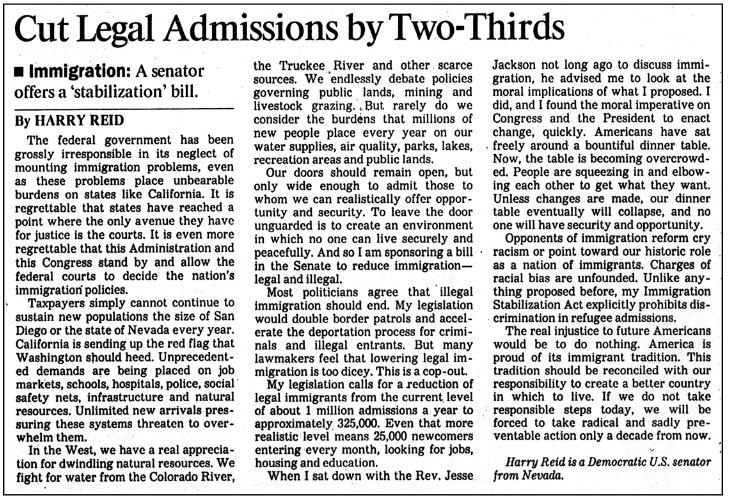Where have you Gone, Harry Reid? (NPG Footnote)
I recently ran across the following OpEd by Senator Harry Reid, the current Senate Majority Leader, in the Los Angeles Times. It is of particular interest in light of the current Senate consideration of S744, a proposal to rewrite the immigration laws to legalize illegal immigrants and increase the flow of immigration.
Continue Reading
Senate Comprehensive Immigration Reform Bill (NPG Footnote)
Senate leaders are rushing to push through SB 744, a bill enticingly titled as the “Border Security, Economic Opportunity and Immigration Modernization Act.” As the title suggests, the bill is a complex blend of interests favored by diverse and at times clashing constituencies.
Continue Reading
Revisiting the Chesapeake Bay
The Effect of Population Growth on America’s Largest Estuary
Click here for a downloadable, printable PDF version The once-acclaimed program to restore the Chesapeake Bay has fallen short of every hopeful ambition. For three decades the Bay’s fundamental declines have barely budged, despite billions of dollars spent on cleanup efforts by the federal government and six states that share the 64,000-square-mile Chesapeake watershed. And many experts feel that if …
Continue Reading
Little Known Presidential Population Leadership
Click here for a downloadable, printable PDF version Those of us familiar with the issue of U.S. population growth are well-acquainted with seeing it summarily ignored by each successive White House administration. Less commonly known are the presidents who initiated studies which led, in some cases, toward policy innovation and broader discussion of the issue of population growth. In this …
Continue Reading
The Southwest: Ground-Zero for Global Warming
Click here for a downloadable, printable PDF version Experts warn that the American Southwest will be the part of the nation hit first, worst and hardest by global warming. But the desert Southwest— what author Wallace Stegner called “the dry core of the West”—could face a civilization-breaking water crisis even without global warming. There is insufficient water for the current …
Continue Reading
Happy Days are Here Again?
There has been a welter of celebratory stories in the popular press claiming that, because of the advent of fracking, our energy problems are over, that we are on the way to ending our dependence on foreign energy sources, and that – as a consequence – any worries about the limits to growth and the transition from fossil fuels are no longer relevant. I will present a less ecstatic analysis.1
Continue Reading
The Meaning of Sustainability
Click here for a downloadable, printable PDF version Background on Sustainabilty In the 1960s and 1970s, it became apparent to many thoughtful individuals that global populations, rates of resource use and environmental degradation were all increasing so rapidly that these increases would soon encounter the limits imposed by the finite productivity of the global ecosphere and the geological availability of …
Continue Reading
Two White Hats (NPG Footnote)
Click here for a downloadable, printable PDF version Money talks, very loud, in American politics. I have pointed out before that American immigration policy is largely set by entrepreneurs seeking cheap labor, not because most people want it.1 In fairness, however, let me say that there is a substantial body of immigration advocates who believe, quite sincerely, that unchecked immigration …
Continue Reading
The Sources of Unemployment
If over the past three decades the United States had deliberately set out to create unemployment, it could hardly have done a more thorough job. The sources of the problem lie in our immigration policy, foreign trade policy, the failure to deal with rising productivity, and our reliance on public and private debt. I will suggest specific solutions. They require a fundamental change in our national thinking to recognize that go-go economic growth is no longer possible at this stage in history.
Our present unemployment problem is not transitory, and it is not confined to the United States. It is much more intense in many countries, particularly the poorest ones, and that in turn will lead to more intense migratory pressures. The more prosperous countries – not just the United States – will need the discipline to match their populations and their policies to their job opportunities, their resources and their food supply. They will need to develop and enforce effective controls over migration, trade and debt to survive amidst unprecedented challenges.
Continue Reading
Is Fracking an Answer? To What?
Click here for a downloadable, printable PDF version box size=”large”Hydraulic fracturing (“fracking” in the popular literature; “fracing” in some technical journals) is a technique for expanding gas and oil production. It is dramatically raising expectations for future gas and oil production, and technological optimists are hailing it as the answer to fears of a decline in world fossil energy production. …
Continue Reading

